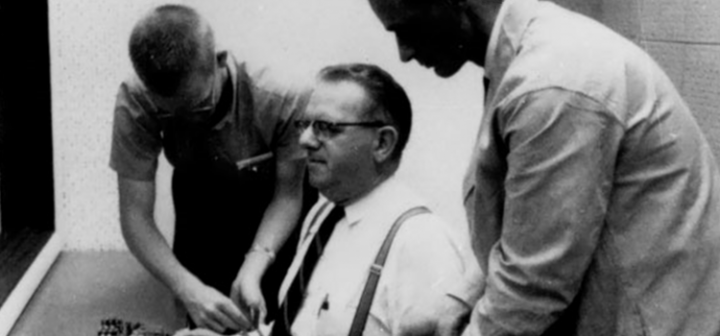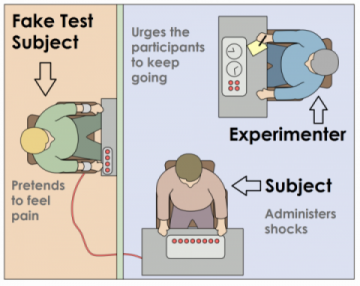Just following orders?

In July 1961 social psychologist Stanley Milgram, from Yale University, conducted what was arguably the most famous and disturbing psychological experiment of all time. This experiment focused on the conflict between obedience to authority and personal conscience.
Participants for the experiment were selected from general society and the demographic was 40 males aged between 20 and 50 who had a wide range of backgrounds, from unskilled labour to educated professional. Each participant was paid $4.50 for their time. All participants believed they were taking part in a learning experiment. The procedure was that the participant was paired with another person, who was a confederate of Milgram’s pretending to be a participant. The real participants were told they would be allocated the role of either learner or teacher. Roles would be decided by drawing lots. The draw, however, was fixed so that the real participant was always the teacher, and the learner, who was an actor, was always the learner.
The learner was taken into a separate room, strapped to a chair and had electrodes attached to his arms. The teacher and researcher, who was the figure of authority overseeing the procedure, went into a room next door that contained an electric shock generator and a row of switches marked from 15 volts (Slight Shock) to 375 volts (Danger: Severe Shock) to 450 volts (XXX).

The real subject, the teacher, was told they were going to be testing the learner on word association. The teacher began by reading a list of word pairs to the learner. The teacher would then read the first word of each pair and read four possible associated answers. The learner would press a button to indicate his response. If the answer was incorrect, the teacher was told to administer a shock to the learner, with the voltage increasing in 15volt increments for each wrong answer. If correct, the teacher was told read the next word pair and so on. Although the teacher believed they were administering shocks, in reality the learner was receiving no shocks at all and just pretending to be hurt.
As the experiment progressed and the shocks got higher the learner (actor) was instructed to cry out in pain and call for the experiment to be halted. This escalated until the learner started banging on the walls demanding to be let out and eventually after a certain level of shock failing to respond altogether.
At the point of the learner complaining many of the teachers expressed concern for the other person and wanted to stop the experiment. At this point, however, the experimenter was primed to prompt the teacher to continue. The prompts were given in a calm and measured way and followed a strict script:
- Please continue.
- The experiment requires that you continue.
- It is absolutely essential that you continue.
- You have no other choice, you must go on.
If the subject still wished to stop after all four successive verbal prompts, the experiment was halted. Otherwise, it was halted after the subject had given the maximum 450-volt shock three times in succession.
Before conducting the experiment, Milgram polled senior psychologists to try and predict what percentage of people would administer the highest and potentially lethal shock. The prediction was that only one tenth of one percent (0.1%) would give the full 450-volts. In reality 65% of the subjects gave the maximum 450-volts. This was even though many were very uncomfortable in doing so. Every participant questioned the experiment and all displayed varying degrees of tension and stress, sweating, trembling, stuttering, biting their lips, groaning, digging their fingernails into their skin, some even having nervous laughing fits or seizures.
According to Milgram, “the essence of obedience consists in the fact that a person comes to view himself as the instrument for carrying out another person’s wishes, and he therefore no longer sees himself as responsible for his actions.”
This may all be very interesting but what has it got to do with safety. Well what does it tell us about a leader’s ability to influence behaviour? A leader is the figure of authority, their vision drives the working culture. Leaders’ words and actions are examined through a microscope, there meaning, and intent are magnified. It is, therefore, crucial that the words and actions of leaders are consistent, unambiguous, explicit and clear. After nearly 25 years in the business of behavioural safety it is my belief that people will largely do what they believe leaders want them to do, even to the point of overriding some of their personal values. Of course, we never ask people to do anything as obvious and extreme as electrocuting people at work. But in subtler ways, what can we potentially be asking people to do?
I am sure we have all come across the following example:
- ‘Safety is important, but it is crucial this job completed by the end of the day”
- ‘It is important we finish by the end of the day, but it is crucial this job is done safely’
I think the difference in emphasis between these two statements is obvious. In 1 it is completing the job by the end of the day that is the inferred priority in 2, although completing the job is important, the finishing emphasis is that safety is the priority. Sometime the message is even more implicit than the above obvious example. Think about an important complex task that is brought in under time and under budget. All good! Well of course it is, but along with the praise do we always take time to ask ‘how’ the task was achieved or are we just happy it was done? How are we exercising our authority? What we don’t say as leaders is just as important as what we do say. There is no such thing as neutral leadership.
And who are leaders? Well, looking to the senior management team is the obvious answer, but at any one time we may all find ourselves in a position of leadership / authority. At these moments we need to stop and consider in which direction am I taking people!
450-volts anyone?





